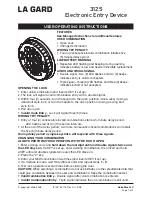
Fieldbus
Communication
•
193
BACnet/IP
WAGO-I/O-SYSTEM 750
BACnet/IP Controller
4.2.1.2.1 Objects
BACnet offers a unified structure for different areas in the network. Thus,
field devices such as probes, controllers of the automation level or even com-
plex control and operating stations of the management level are modeled in
the object representation. The 25 objects are tailored specifically to the HVAC
sector for building automation services. They contain both physical inputs and
outputs and virtual objects.
Tab. 4-36: BACnet objects
Object
Function
1
Accumulator
Count value entry; counts values
2
Analog Input
Analog inputs, measures voltage, temperature,
etc.
3
Analog Output
Analog outputs, e.g. for setting controllers
4
Analog Value
Analog value; e.g. from a calculation
5
Averaging
Average for calculations and statistics
6
Binary Input
Binary input, reports an event or disturbance
7
Binary Output
Binary output; alternates between two states
8
Binary Value
Binary value, virtual binary data time
9
Calendar
Operating calendar, list of holidays and vacations
10 Command
(Group) request to execute predefined activities
(e.g. a list of switching commands)
11 Device
Device, information on the respective BACnet
device
12 Event Enrollment
Event category, defined reactions to events
13 File
File, transmits data
14 Group
Group entry, grouped object values in the device
15 Life-Safety-Point
Hazard reporter, delivers information on proper-
ties with regard to notifications of danger
16 Life-Safety-Zone
Security area, includes hazard reporting objects
according to certain criteria
17 Loop
Controller, performs regulation functions
18 Multi-State Input
Multi-level input, delivers reports on states such
as off/on, open/closed as a coded number
19 Multi-State Output
Multi-level output, delivers the output states of
commands
















































